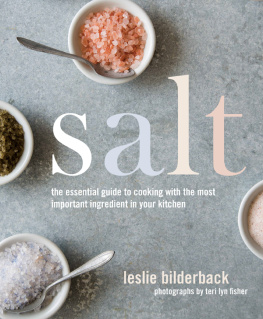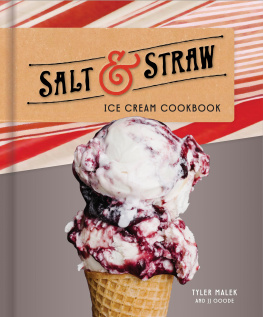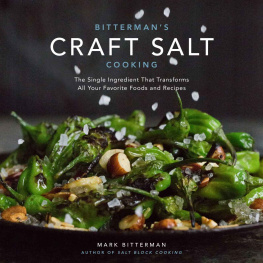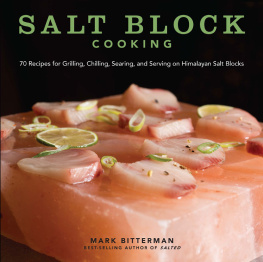
Text copyright 2015 Jessica Harlan and Kelley Sparwasser. Photographs copyright 2015 JudiSwinksPhotography.com. Illustrations copyright 2015 Suman Kasturia. Design and concept copyright 2015 Ulysses Press and its licensors. All rights reserved. Any unauthorized duplication in whole or in part or dissemination of this edition by any means (including but not limited to photocopying, electronic devices, digital versions, and the Internet) will be prosecuted to the fullest extent of the law.
Published in the U.S. by:
Ulysses Press
P.O. Box 3440
Berkeley, CA 94703
www.ulyssespress.com
ISBN13: 978-1-61243-509-1
Acquisitions editor: Casie Vogel
Project editor: Alice Riegert
Managing editor: Claire Chun
Editor: Susan Lang
Proofreader: Renee Rutledge
Cover design: Rebecca Lown
Interior design and layout: what!design @ whatweb.com
Photography: Judi Swinks Photography; back cover salt block Alexey Borodin/shutterstock.com
Food stylist: Anna Hartman-Kenzler
Illustrator: Suman Kasturia
Index: Sayre Van Young
Distributed by Publishers Group West
IMPORTANT NOTE TO READERS: This book is independently authored and published and no sponsorship or endorsement of this book by, and no affiliation with, any trademarked brands or other products mentioned within is claimed or suggested. All trademarks that appear in this book belong to their respective owners and are used here for informational purposes only. The authors and publisher encourage readers to patronize the quality brands and products mentioned in this book.
For Adam. KS
For Chip, Sadie, and Gillian youre the salt to my pepper. JH

CONTENTS

Salt of the earth.
Worth her salt.
Pouring salt in the wound.
Take with a grain of salt.
Back to the salt mines.

Its no coincidence that idioms about salt both positive and negative are so pervasive in the English lexicon. After all, salt literally flows through our veins, an essential mineral without which we would perish.
Salt is one of our oldest food seasonings, and was the first preservative enabling humans to survive through scarcity. Its not surprising that its significance led to its use as a currency and a trade commodity (in fact, the word salary has its origins in the rations of salt given to soldiers).
While we wont be paying our mortgages with sacks of salt, theres no denying that salt is still integral to our culture, not only as the essential mineral its always been, but as a cultural phenomenon. Head to the grocery store to refill your saltcellar and youll choose from table salt, kosher salt, various sea salts, flaky salt, pink salt, black salt, and the list goes on.
Himalayan salt blocks are beautiful, marbled pink slabs of salt carved from deep within the Himalayan mountains in Pakistan. This salt, formed beneath the earth from ancient seabeds and protected for thousands of years by virtue of its inaccessibility, is unadulterated by pollution and other impurities. It contains trace minerals that give it a more complex flavor than standard table or kosher salt, and iron oxide, which lends it a striking pink color.
Because of their high moisture content, salt blocks naturally conduct and retain heat to extreme temperatures, which means they can be heated to a temperature hot enough to cook on, and chilled so they can be used to display and lower the temperature of foods. On the following pages, well show you how to use salt blocks on the stove, in the oven, and even on the grill and in the smoker, to create delicious, perfectly seasoned meals.
A TECHNIQUE WORTH MASTERING
Were not going to lie: Cooking with a salt block can be a challenge. Newcomers to this cooking technique might find that a salt block heats unevenly, will crack if its not heated and cooled just so, and can be a pain to clean and maintain.
So why bother? When you master the art of cooking on a salt block, youll be richly rewarded. Youll taste the best seared steak of your life. Youll be treated to tender vegetables that are perfectly seasoned. Youll impress dinner guests with stunning presentations.
We liken cooking on a salt block to cooking over a campfire. It takes a while to get started, and the heating is a bit inconsistent and a bit unreliable but its a fun, unique way of cooking, and the results are simply delicious!
Well equip you with the instructions, techniques, and recipes you need to use your salt block to its best advantage. With a little practice and the recipes in this book, youll soon learn to love cooking on salt blocks as much as we do. Its now the only way we bake (page 76).
So follow along with us and learn how to make a true piece of earths history into one of your favorite cooking tools.


SALT TRIVIA
Sodium is instrumental in brain function and signals to and from the brain.
The addition of salt to food enhances flavor by allowing the food to release molecules into the air, boosting the aroma of the food, and therefore how we taste it. Salt also helps to decrease bitter flavors in food.
The word salad is derived from the Latin word for salt (sal), because Romans often brined their vegetables.
Many people believe that Himalayan salt has numerous health benefits, from regulating sleep to preventing varicose veins to acting as an antihistamine. There are even spas that have salt-lined rooms for salt therapy.
In the early 1800s in the United States, salt was four times more expensive than beef, since it played an important part in keeping people and livestock alive and healthy.
Some people swear by a pinch of salt in their coffee grounds before brewing, saying it removes some of the bitter or acidic flavor.

CHOOSING YOUR SALT BLOCK
As ancient as salt blocks are, there are very few offerings in the marketplace and not a lot of variety in terms of size and shape.
The most common salt block is made by California-based Charcoal Companion, and its 12 inches by 8 inches and 1-1/2 inches thick, just big enough to fit over a regular burner. Depending on where you buy it, this same salt block can range in price from $30 to $50, so be sure to shop around for the best price. While we bought ours at Cost Plus World Market, blocks can be found at Crate & Barrel, Home Depot, Sur la Table, Williams-Sonoma, and more.
Another offering is from Salt Rox, based in Kentucky. Founder John Tucker has developed a proprietary technique to treat his salt blocks so they are more durable and can be brought to temperature more quickly without breaking. The companys salt blocks are 2 inches thick and come in various sizes. The company also offers serving plates, shot glasses, and bowls made of salt, as well as granules of salt for seasoning.
Next page













